 |
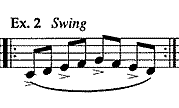 |
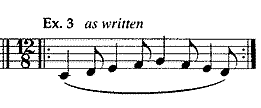 |
We can turn these three negatives into three positive instructions for the developing jazz musician pursuing a mature swing feel in eighth-note lines:
|
This article is copyright 2000, 2006 by Antonio J. García and originally was published in Selmer Bach Brass Notes, 2000 and then the International Trombone Association Journal, Vol. 34, No. 2, April 2006. It is used by permission of the author and, as needed, the publication. Some text variations may occur between the print version and that below. All international rights remain reserved; it is not for further reproduction without written consent. |
Learning Swing Feel
or
How to Sculpt an Elephant
by Antonio J. García
Associate Jazz Editor, ITA Journal
Teaching someone how to swing eighth-note lines in jazz is comparable to dictating how much seasoning to include in fine food...or what degree of color to mix in a painting...or how much “drawl” to include in an actor’s southern accent. They are all indefinable. We know they’re right when we taste them, see them, or hear them—but even what’s “right” is subject not only to cultural traditions but also to our own personal experiences and beliefs.
Easier than describing what’s right is declaring what has gone wrong: too much spice, too faint a red, too extreme an accent as to be believable for us. And our credibility depends on our experience in the idiom: how much we’ve studied—if not also actively participated in—the expressiveness of the art form. In some ways, the concept of swing eighth notes is the Holy Grail of jazz: the priceless essence of the developing jazz musician’s quest. The following information applies to voice or any external instrument. No matter how correct the scales, hip the chord substitutions, or current the licks, if a player can’t swing, no one wants to listen for very long!
Years ago an article described how someone in the quest for the Grail had used a computer to analyze the swing eighth notes of a Bill Evans piano solo. Would technology reveal the mystic equation calculating where—between even eighths and triplet-eighths—true swing eighths fall? Such a definable proportion could then be easily passed from one generation to another. But the study revealed a challenging truth: no two swing eighths in Evans’ solo fell the same distance apart. He followed no formula, and none could be passed on to the reader as the prize so long sought.
Avoiding the Problem
Swing eighths are the vernacular in the swing and bebop vocabulary: all great jazz musicians use them as the foundation of their expression. But in an improvisational music like jazz, a musician might choose to avoid expressive possibilities that present technical challenges. Listen to developing players solo: you’ll often find that they prefer to solo in triplet quarters, triplet eighths, quarters, halves—anything but swing eighths. This is the root of why they sound less mature: they can’t swing.
To reveal this further, require yourself or your young student to perform a solo comprised mostly or all of swing eighths and various rests: when players lack experience swinging, the lines usually stop quickly. Any previous content playable as triplets or sixteenths often suddenly seems less usable because players might be uncomfortable crafting a line in eighths—without which they will never sound mature within the swing and bebop idioms.
So when such persons solo, they avoid eighths like the plague. They know they can place quarters and triplets properly; so why choose their swing-eighths, which they recognize as sounding either stiff or “hokey”? Thus they avoid addressing a fundamental element of playing jazz.
Let’s assume the challenge is your students’. Getting them comfortable with performing swing eighths is “job one.” But how can they best learn the indefinable?
Defining Swing Eighths
There is no substitute for listening to the jazz masters—and even more importantly, for imitating them. All great jazz musicians have spent a lifetime listening to and learning from their predecessors and peers, and anyone seeking to absorb this art form should expect to do nothing less. How else can one internalize the different swing feels of Louis Armstrong vs. Clifford Brown vs. Ella Fitzgerald vs. J.J. Johnson vs. Charlie Parker vs. Bill Evans vs. Mary Lou Williams vs. Frank Rosolino vs. Lennie Tristano...and all the other great jazz musicians?
My students are also required not only to listen to but also to scat-sing along in unison with recorded swinging solos of the jazz masters that they pick (approved to be within technical reach). By doing so, they digest what’s most important about jazz phrasing, thematic construction, pacing, dynamics—all the elements so difficult to learn out of a book. Even when they later play along with the recorded solo on their “axe,” no written music is initially involved in the process. Listening and imitating is critical, far much more so than writing it out (which should come later).
Even with the masters constantly instructing my students as to how to phrase swing lines, there’s still more that I can do to assist.
Two Ways to Sculpt an Elephant
Some visual artists may possess a great eye and skill for sculpting an image of, say, an elephant. But if others are good enough at knocking everything away that isn’t an elephant, they’ll also attain a fine result. It is said that Michelangelo approached sculpting “David” not as newly forming an image but as releasing the image already “captive” within the stone.
Similarly, few less-experienced jazz musicians—even those having listened a great deal to the jazz masters—can grow directly to a mature swing-eighth style. I find that the most effective path for most students (along with listening) is to recognize and avoid what is not good swing style. By chipping away at the “stone”—the less-mature styles that definitely aren’t suited to their goal—they are quickly left with a far stronger swing style.
“Anti-Swing” & Swing
Professional jazz musicians know how not to swing. In fact, students hearing a concert of their peers can usually identify when others aren’t swinging. The three most common detractors hindering swing style in eighth-note lines are as follows:
The eighths in the line are phrased awkwardly, typically in “short-long, short-long” groupings (Ex. 1).
The downbeats within the eighth line are accented (Ex. 2).
The eighths are either phrased evenly or (more often) as extreme triplets, quasi-12/8-feel (Ex. 3).
 |
 |
 |
We can turn these three negatives into three positive instructions for the developing jazz musician pursuing a mature swing feel in eighth-note lines:
Play all eighths long unless marked otherwise, even if followed by a rest (Ex. 4). “Long” means that no decay or decrescendo in the sound is present. (For wind-players, this means that the line should be performed via one unbroken air-stream rather than by a series of puffs of air, whereas for a pianist, this means each note must be held down by a finger until the next note is struck.)
Accent upbeats rather than downbeats (Ex. 5), unless otherwise prompted by leaps.
Place the degree of swing-eighth feel somewhere between 12/8 and an even 4/4 or 8/8 (Ex. 6).
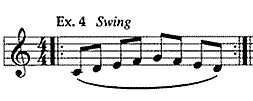 |
 |
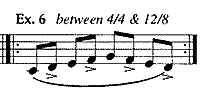 |
I require my students to demonstrate command of these three factors on a variety of scales and arpeggios. Many classically trained students who seemingly can play any scale in even eighths cannot initially get through one octave of a major scale while observing these three new instructions. It’s perfectly natural: a person who has mastered juggling three or four balls will falter with five or six as part of the learning process. Typically a student might play all eighths long but accenting downbeats—or play them long and accented on upbeats but in a “triplety” 12/8 feel. Maturing takes practice by the student—and diligence on the part of the observing educator to inform students what they have mastered and what they are not yet achieving.
We all know how hard it is to break an old habit: it’s far easier to learn new options. Short of electrical damage to the brain, you can’t willingly erase neural pathways, anyway: you create new ones from which to make choices. There’s no need to banish the three “anti-swing” factors from one’s vocabulary; they will likely be expressive tools at one moment or another. But it is critical to add these new skills. Since it’s often difficult for anyone to be really sure they are effectively changing styles in the practice room, I encourage students to alternate playing one or two measures of “anti-swing” with one or two of the more mature swing styles (Ex. 7). By making “A/B samples,” aural comparisons usually steer students in the positive direction.
 |
Within the Groove
An essential corollary to the above three instructions is that players be able to perform good swing style over a metronome sounding on beats two and four—the ground beat of 4/4 swing at a medium tempo. A metronome set to half note = 60 but initiated on the second quarter note of the measure, for example, imitates a drummer’s high-hat on beats two and four (Ex. 8). This proves to be disorienting for many students—which is precisely why they’re uncomfortable with a swing ground beat from a drummer and bassist emphasizing two and four. Many insist: “I can perform the material in swing style if you’d just turn off that metronome”—and then prove they can. But until they can perform it hearing the ground beat of medium-tempo jazz swing on that metronome, adding a rhythm section later merely distracts listeners from their inability to swing within the groove.
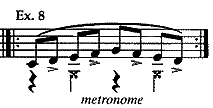 |
Thus I require students in my Jazz Improvisation lessons to perform various scales and chords with the three swing-phrasing elements present—and over a ground beat of two and four. Given this goal’s importance in the overall course grade, students address swing in the disciplined manner they would otherwise choose to avoid in favor of learning more tunes or chord substitutions (which won’t make a difference to the listener if the musicians can’t swing!)
Scale Choices
Though I happen to require all the modes of the major scale (among others) to be played observing these factors, students can achieve some immediate goals by addressing only the first and second degrees: Ionian and Dorian modes (Ex. 9). By doing so, students have to accent first one set of upbeat pitches (via Ionian), then the opposite set of upbeat pitches (via Dorian). Learning only one mode avoids half the challenge of controlling the instrument beyond its idiomatic scale accents. And practicing the two modes in several keys greatly increases one’s ability to swing lines without prompting the old, default “anti-swing” phrasing.
 |
Repeated Notes
As exciting and attractive as it is for students to rattle off myriad lines, practicing only changing pitches ignores yet another essential element of swing. For many students, one of the biggest challenges is not swinging chords or scales but repeated single pitches à la “Sweets Edison,” “Lockjaw” Davis, Bennie Green, Count Basie, and other jazz masters. Instead of swinging, students’ single-pitch attempts often come out phrased with some note-groupings unsustained, downbeat-accented, and/or in a 12/8 or even 4/4 feel (Ex. 10).
 |
While eighth lines of same pitch are an idiomatic challenge to string and percussion instruments (piano, bass, guitar, vibes, and even drums), they often defy initial efforts by wind players as well. A useful approach is to swing a pitch alternating with surrounding pitches in eighths, then return to a measure of the single pitch in eighths (Ex. 11), thus modeling the latter after a style already attained.
 |
Repeated short quarter notes are generally played short but fat. This stems from the father of all contemporary jazz phrasing, Louis Armstrong, who played his repeated quarters roughly two-thirds of a beat long, thus implying via the silence the missing, swinging eighth between the downbeat quarters (Ex. 12). This made his quarter notes swing more than his predecessors’ short quarters of half-length or less.
 |
Finally, rests are an essential element of jazz phrasing. By making the rests swing, an aspiring jazz musician can make the notes swing far better! This parallels visual art: persons drawing a single vine strewn around a light-colored pole will have far greater success when they recognize not only the shape of the leaves but draw the shapes created between the leaves, where the pole is visible. Such “negative space” defines the boundary of each leaf—just as rests define the shape and feel of the notes they surround in a swing line. To emphasize that negative space, place a tongue-stop at the end of all short notes: for example, in a series of four short, downbeat quarter notes, place a tongue-stop on each of the four following upbeats.
A Clearer Path
In summary, there remains no substitute for listening to great jazz musicians; but imitating them (vocally and instrumentally) is essential to effective growth. Insist that students confront their concerns about swing eighth notes rather than avoid them. While it’s impossible to define swing eighths, it’s far easier to define what aren’t swing eighths and then seek the alternative.
Recognize the phrasing elements common in students who aren’t swinging well; require opposite elements as positive goals (to be practiced in alternation with the old habits). Be sure students can swing over a metronome on two and four at a moderate tempo, also addressing repeated eighth and quarter-note pitches, while shaping the rests to imply swing.
Continue to focus on these elements of swing within any improvised student solos over tunes in classes or lessons: cumulatively maintain a high standard of swing. If you require that students devote the same attention to developing swing feel as to learning tunes or chord progressions, you will be impressed by how much progress they can achieve in even a single semester of study.
***********
Selected Articles on Phrasing by the Author
Fine-Tuning Your Ensemble’s Jazz Style” (MENC Music Educators Journal, February 1991)
Pedagogical Scat” (MENC Music Educators Journal, September 1990)
Versions of this article
have appeared in Selmer Bach Brass Notes and in info@long-mcquade.com.
To see a video of a student working through these concepts, complete with "before" and "after" samples, visit here. To see and hear sound files of several rhythmic-phrasing examples pertinent to the above article, see this PDF and this PDF for visual and hear this mp3 for corresponding audio examples, plus see this PDF for visual and hear this mp3 for audio. I am grateful to Shoichi Chou, who generously translated this article into Chinese as well as into a Chinese/English version.
_ _ _ _ _ _ _ _ _ _ _ _ _ _ _
Antonio J. García is a Professor Emeritus and former Director of Jazz Studies at Virginia Commonwealth University, where he directed the Jazz Orchestra I; instructed Applied Jazz Trombone, Small Jazz Ensemble, Jazz Pedagogy, Music Industry, and various jazz courses; founded a B.A. Music Business Emphasis (for which he initially served as Coordinator); and directed the Greater Richmond High School Jazz Band. An alumnus of the Eastman School of Music and of Loyola University of the South, he has received commissions for jazz, symphonic, chamber, film, and solo works—instrumental and vocal—including grants from Meet The Composer, The Commission Project, The Thelonious Monk Institute, and regional arts councils. His music has aired internationally and has been performed by such artists as Sheila Jordan, Arturo Sandoval, Jim Pugh, Denis DiBlasio, James Moody, and Nick Brignola. Composition/arrangement honors include IAJE (jazz band), ASCAP (orchestral), and Billboard Magazine (pop songwriting). His works have been published by Kjos Music, Hal Leonard, Kendor Music, Doug Beach Music, ejazzlines, Walrus, UNC Jazz Press, Three-Two Music Publications, Potenza Music, and his own garciamusic.com, with five recorded on CDs by Rob Parton’s JazzTech Big Band (Sea Breeze and ROPA JAZZ). His scores for independent films have screened across the U.S. and in Italy, Macedonia, Uganda, Australia, Colombia, India, Germany, Brazil, Hong Kong, Mexico, Israel, Taiwan, and the United Kingdom. One of his recent commissions was performed at Carnegie Hall by the Orpheus Chamber Orchestra.
A Conn-Selmer trombone clinician, Mr. García serves as the jazz clinician for The Conn-Selmer Institute. He has freelanced as trombonist, bass trombonist, or pianist with over 70 nationally renowned artists, including Ella Fitzgerald, George Shearing, Mel Tormé, Doc Severinsen, Louie Bellson, Dave Brubeck, and Phil Collins—and has performed at the Montreux, Nice, North Sea, Pori (Finland), New Orleans, and Chicago Jazz Festivals. He has produced recordings or broadcasts of such artists as Wynton Marsalis, Jim Pugh, Dave Taylor, Susannah McCorkle, Sir Roland Hanna, and the JazzTech Big Band and is the bass trombonist on Phil Collins’ CD “A Hot Night in Paris” (Atlantic) and DVD “Phil Collins: Finally...The First Farewell Tour” (Warner Music). An avid scat-singer, he has performed vocally with jazz bands, jazz choirs, and computer-generated sounds. He is also a member of the National Academy of Recording Arts & Sciences (NARAS). A New Orleans native, he also performed there with such local artists as Pete Fountain, Ronnie Kole, Irma Thomas, and Al Hirt.
Most of all, Tony is dedicated to assisting musicians towards finding their joy. His 35-year full-time teaching career and countless residencies in schools have touched tens of thousands of students in Canada, Europe, South Africa, Australia, The Middle East, and across the U.S. His collaborations highlighting jazz and social justice have raised hundreds of thousands of dollars, providing education to students and financial support to African American, Latinx, LGBTQ+, and Veterans communities, children’s medical aid, and women in jazz. He serves as a Research Faculty Member at the University of KwaZulu-Natal. His partnerships with South Africa focusing on racism and healing resulted in his performing at the Nelson Mandela National Memorial Service in D.C. in 2013. He also fundraised $5.5 million in external gift pledges for the VCU Jazz Program.
Mr. García is the Past Associate Jazz Editor of the International Trombone Association Journal. He has served as a Network Expert (for Improvisation Materials), President’s Advisory Council member, and Editorial Advisory Board member for the Jazz Education Network . His newest book, Jazz Improvisation: Practical Approaches to Grading (Meredith Music), explores avenues for creating structures that correspond to course objectives. His book Cutting the Changes: Jazz Improvisation via Key Centers (Kjos Music) offers musicians of all ages the opportunity to improvise over standard tunes using just their major scales. He is Co-Editor and Contributing Author of Teaching Jazz: A Course of Study (published by NAfME), authored a chapter within Rehearsing The Jazz Band and The Jazzer’s Cookbook (published by Meredith Music), and contributed to Peter Erskine and Dave Black’s The Musician's Lifeline (Alfred). Within the International Association for Jazz Education he served as Editor of the Jazz Education Journal, President of IAJE-IL, International Co-Chair for Curriculum and for Vocal/Instrumental Integration, and Chicago Host Coordinator for the 1997 Conference. He served on the Illinois Coalition for Music Education coordinating committee, worked with the Illinois and Chicago Public Schools to develop standards for multi-cultural music education, and received a curricular grant from the Council for Basic Education. He has also served as Director of IMEA’s All-State Jazz Choir and Combo and of similar ensembles outside of Illinois. He is the only individual to have directed all three genres of Illinois All-State jazz ensembles—combo, vocal jazz choir, and big band—and is the recipient of the Illinois Music Educators Association’s 2001 Distinguished Service Award.
Regarding Jazz Improvisation: Practical Approaches to Grading, Darius Brubeck says, "How one grades turns out to be a contentious philosophical problem with a surprisingly wide spectrum of responses. García has produced a lucidly written, probing, analytical, and ultimately practical resource for professional jazz educators, replete with valuable ideas, advice, and copious references." Jamey Aebersold offers, "This book should be mandatory reading for all graduating music ed students." Janis Stockhouse states, "Groundbreaking. The comprehensive amount of material García has gathered from leaders in jazz education is impressive in itself. Plus, the veteran educator then presents his own synthesis of the material into a method of teaching and evaluating jazz improvisation that is fresh, practical, and inspiring!" And Dr. Ron McCurdy suggests, "This method will aid in the quality of teaching and learning of jazz improvisation worldwide."
About Cutting the Changes, saxophonist David Liebman states, “This book is perfect for the beginning to intermediate improviser who may be daunted by the multitude of chord changes found in most standard material. Here is a path through the technical chord-change jungle.” Says vocalist Sunny Wilkinson, “The concept is simple, the explanation detailed, the rewards immediate. It’s very singer-friendly.” Adds jazz-education legend Jamey Aebersold, “Tony’s wealth of jazz knowledge allows you to understand and apply his concepts without having to know a lot of theory and harmony. Cutting the Changes allows music educators to present jazz improvisation to many students who would normally be scared of trying.”
Of his jazz curricular work, Standard of Excellence states: “Antonio García has developed a series of Scope and Sequence of Instruction charts to provide a structure that will ensure academic integrity in jazz education.” Wynton Marsalis emphasizes: “Eight key categories meet the challenge of teaching what is historically an oral and aural tradition. All are important ingredients in the recipe.” The Chicago Tribune has highlighted García’s “splendid solos...virtuosity and musicianship...ingenious scoring...shrewd arrangements...exotic orchestral colors, witty riffs, and gloriously uninhibited splashes of dissonance...translucent textures and elegant voicing” and cited him as “a nationally noted jazz artist/educator...one of the most prominent young music educators in the country.” Down Beat has recognized his “knowing solo work on trombone” and “first-class writing of special interest.” The Jazz Report has written about the “talented trombonist,” and Cadence noted his “hauntingly lovely” composing as well as CD production “recommended without any qualifications whatsoever.” Phil Collins has said simply, “He can be in my band whenever he wants.” García is also the subject of an extensive interview within Bonanza: Insights and Wisdom from Professional Jazz Trombonists (Advance Music), profiled along with such artists as Bill Watrous, Mike Davis, Bill Reichenbach, Wayne Andre, John Fedchock, Conrad Herwig, Steve Turre, Jim Pugh, and Ed Neumeister.
Tony is the Secretary of the Board of The Midwest Clinic and a past Advisory Board member of the Brubeck Institute. The partnership he created between VCU Jazz and the Centre for Jazz and Popular Music at the University of KwaZulu-Natal merited the 2013 VCU Community Engagement Award for Research. He has served as adjudicator for the International Trombone Association’s Frank Rosolino, Carl Fontana, and Rath Jazz Trombone Scholarship competitions and the Kai Winding Jazz Trombone Ensemble competition and has been asked to serve on Arts Midwest’s “Midwest Jazz Masters” panel and the Virginia Commission for the Arts “Artist Fellowship in Music Composition” panel. He was published within the inaugural edition of Jazz Education in Research and Practice and has been repeatedly published in Down Beat; JAZZed; Jazz Improv; Music, Inc.; The International Musician; The Instrumentalist; and the journals of NAfME, IAJE, ITA, American Orff-Schulwerk Association, Percussive Arts Society, Arts Midwest, Illinois Music Educators Association, and Illinois Association of School Boards. Previous to VCU, he served as Associate Professor and Coordinator of Combos at Northwestern University, where he taught jazz and integrated arts, was Jazz Coordinator for the National High School Music Institute, and for four years directed the Vocal Jazz Ensemble. Formerly the Coordinator of Jazz Studies at Northern Illinois University, he was selected by students and faculty there as the recipient of a 1992 “Excellence in Undergraduate Teaching” award and nominated as its candidate for 1992 CASE “U.S. Professor of the Year” (one of 434 nationwide). He is recipient of the VCU School of the Arts’ 2015 Faculty Award of Excellence for his teaching, research, and service, in 2021 was inducted into the Conn-Selmer Institute Hall of Fame, and is a 2023 recipient of The Midwest Clinic's Medal of Honor. Visit his web site at <www.garciamusic.com>.
If you entered this page via a search
engine and would like to visit more of this site,
For further information on the International
Trombone Association Journal, see